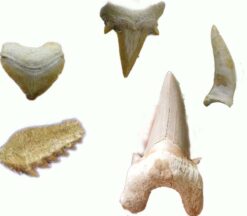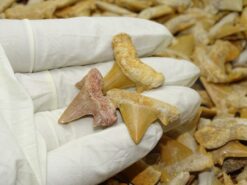The megalodon is the largest shark to have ever lived in the world’s ocean. Like other sharks, they had streamlined yet powerful bodies built to efficiently cut through the water. Their tailfin undulated side to side and they breathed through gill slits on either side of their head.
Like other elasmobranchs (a group of fishes that includes sharks, rays, and skates), megalodons have skeletons mostly made of cartilage—the hard but flexible material that is found in human noses and ears. This is a defining feature of elasmobranchs, as most fish have skeletons made of bone. Much lighter than bone, cartilage allows sharks to stay afloat and swim long distances while using less energy. It is also very difficult for cartilage to fossilize, so much of what we know about megalodons comes from their teeth, vertebrae (which contain calcium and therefore are preserved), and fossilized poop. The proposed shape of a megalodon is therefore based on the anatomy of living sharks. Modern research shows that the megalodon is most closely related to mako sharks, not to the Great White.
Every shark, including the megalodon, has several rows of teeth lining its jaw. Unlike people, who have a limited number of teeth in their lifetime, sharks constantly shed their teeth and replace them with new ones. A shark can lose and replace thousands of teeth in its lifetime. Megalodon teeth are no different, and their teeth can be found scattered on coastal beaches or just offshore. They are especially large—some reach over 7 inches (18 cm) in vertical height.


